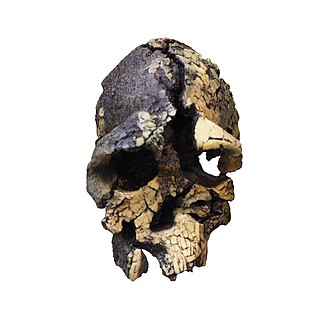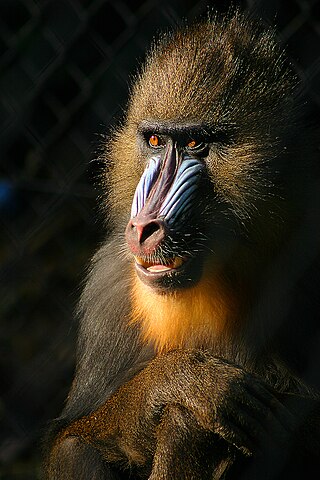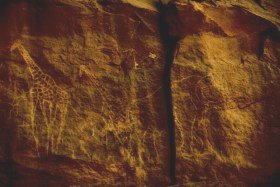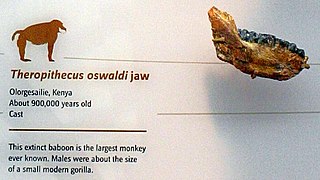
Kenyanthropus is a hominin genus identified from the Lomekwi site by Lake Turkana, Kenya, dated to 3.3 to 3.2 million years ago during the Middle Pliocene. It contains one species, K. platyops, but may also include the 2 million year old Homo rudolfensis, or K. rudolfensis. Before its naming in 2001, Australopithecus afarensis was widely regarded as the only australopithecine to exist during the Middle Pliocene, but Kenyanthropus evinces a greater diversity than once acknowledged. Kenyanthropus is most recognisable by an unusually flat face and small teeth for such an early hominin, with values on the extremes or beyond the range of variation for australopithecines in regard to these features. Multiple australopithecine species may have coexisted by foraging for different food items, which may be reason why these apes anatomically differ in features related to chewing.

Old World monkey is the common English name for a family of primates known taxonomically as the Cercopithecidae. Twenty-four genera and 138 species are recognized, making it the largest primate family. Old World monkey genera include baboons, red colobus and macaques. Common names for other Old World monkeys include the talapoin, guenon, colobus, douc, vervet, gelada, mangabey, langur, mandrill, surili (Presbytis), patas, and proboscis monkey. Phylogenetically, they are more closely related to apes than to New World monkeys. They diverged from a common ancestor of New World monkeys around 45 to 55 million years ago.

Wilhelm Peter Eduard Simon Rüppell, also spelled Rueppell was a German naturalist and explorer, best known for his collections and descriptions of plants and animals from Africa and Arabia.

The gelada, sometimes called the bleeding-heart monkey or the gelada baboon, is a species of Old World monkey found only in the Ethiopian Highlands, living at elevations of 1,800–4,400 m (5,900–14,400 ft) above sea level. It is the only living member of the genus Theropithecus, a name derived from the Greek root words for "beast-ape". Like its close relatives in genus Papio, the baboons, it is largely terrestrial, spending much of its time foraging in grasslands, with grasses comprising up to 90% of its diet.

Robin Ian MacDonald Dunbar is a British anthropologist and evolutionary psychologist and a specialist in primate behaviour. He is currently head of the Social and Evolutionary Neuroscience Research Group in the Department of Experimental Psychology at the University of Oxford. He is best known for formulating Dunbar's number, a measurement of the "cognitive limit to the number of individuals with whom any one person can maintain stable relationships".

Mrs. Ples is the popular nickname for the most complete skull of an Australopithecus africanus ever found in South Africa. Many Australopithecus fossils have been found near Sterkfontein, about 40 kilometres (25 mi) northwest of Johannesburg, in a region of Gauteng now designated as the Cradle of Humankind World Heritage Site. Mrs. Ples was discovered by Robert Broom and John T. Robinson on April 18, 1947. Because of Broom's use of dynamite and pickaxe while excavating, Mrs. Ples's skull was blown into pieces and some fragments are missing. Nonetheless, Mrs./Mr. Ples is one of the most "perfect" pre-human skulls ever found. The skull is currently held at the Ditsong National Museum of Natural History in Pretoria.

Theropithecus is a genus of primates in the family Cercopithecidae. It contains a single living species, the gelada, native to the Ethiopian Highlands.

The Cercopithecinae are a subfamily of the Old World monkeys, which comprises roughly 71 species, including the baboons, the macaques, and the vervet monkeys. Most cercopithecine monkeys are limited to sub-Saharan Africa, although the macaques range from the far eastern parts of Asia through northern Africa, as well as on Gibraltar.
Hadar or Hadar Formation is a paleontological fossil site located in Mille district, Administrative Zone 1 of the Afar Region, Ethiopia, 15 km upstream (west) of the A1 road's bridge across the Awash River.

The Sahara pump theory is a hypothesis that explains how flora and fauna migrated between Eurasia and Africa via a land bridge in the Levant region. It posits that extended periods of abundant rainfall lasting many thousands of years in Africa are associated with a "wet-green Sahara" phase, during which larger lakes and more rivers existed. This caused changes in the flora and fauna found in the area. Migration along the river corridor was halted when, during a desert phase 1.8–0.8 million years ago (mya), the Nile ceased to flow completely and possibly flowed only temporarily in other periods due to the geologic uplift of the Nile River region.

Papionini is a tribe of Old World monkeys that includes several large monkey species, which include the macaques of North Africa and Asia, as well as the baboons, geladas, mangabeys, kipunji, drills, and mandrills, which are essentially from sub-Saharan Africa. It is typically divided into two subtribes: Macacina for the genus Macaca and its extinct relatives and the Papionina for all other genera.

Indopithecus giganteus is an extinct species of large ape that lived in the late Miocene of the Siwalik Hills in northern India. Although frequently assigned to the more well-known genus Gigantopithecus, recent authors consider it to be a distinct genus in its own right.

Dinopithecus is an extinct genus of very large primate closely related to the baboon that lived during the Pliocene to the Pleistocene epoch of South Africa and Ethiopia. It was named by British paleontologist Robert Broom in 1937. The only species currently recognized is Dinopithecus ingens, as D. quadratirostris has been reassigned to the genus Soromandrillus. It is known from several infilled cave sites in South Africa, all of early Pleistocene age, including Skurweberg, Swartkrans, and Sterkfontein.

Theropithecus brumpti was a large terrestrial monkey that lived in the mid to late Pliocene. It is an extinct species of papionin.

The Ethiopian montane grasslands and woodlands is a montane grasslands and shrublands ecoregion in Ethiopia. It occupies the middle elevations of the Ethiopian Highlands, between the high-altitude Ethiopian montane moorlands and the lower-elevation Ethiopian montane forests.
Leonard Harrison Matthews FRS was a British zoologist, especially known for his research and writings on marine mammals.

Theropithecus oswaldi is an extinct species of Theropithecus from the early to middle Pleistocene of Kenya, Ethiopia, Tanzania, South Africa, Spain, Morocco and Algeria. It appears to have been a specialised grazer. The species went extinct in South Africa around 1.0 Ma. Having existed alongside hominins like Homo erectus, it is likely that conflict with early humans played a role in their extinction as a site has been found with many juveniles butchered.

Nina G. Jablonski is an American anthropologist and palaeobiologist, known for her research into the evolution of skin color in humans. She is engaged in public education about human evolution, human diversity, and racism. In 2021, she was elected to the U.S. National Academy of Sciences and in 2009, she was elected to the American Philosophical Society. She is an Evan Pugh University Professor at The Pennsylvania State University, and the author of the books Skin: A Natural History, Living Color: The Biological and Social Meaning of Skin Color, and the co-author of Skin We Are In.
Bolt's Farm is a palaeontological site in the Cradle of Humankind World Heritage Site, Gauteng province, South Africa. With more than 30 fossil deposits dating back 4.5 Ma, it is one of the oldest sites currently discovered in the Cradle of Humankind. It consists of multiple cavities, pits, and quarries, where caves have eroded away, exposing their fossiliferous interiors. Although this site has not yet yielded the hominid fossils for which the Cradle of Humankind is known, Bolt's Farm is still an important source of fossils from various species of Early Pliocene and Plio-Pleistocene fauna, including primates and big cats.














